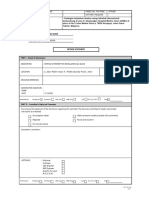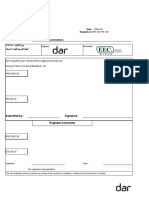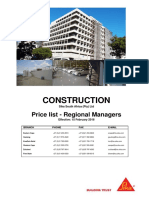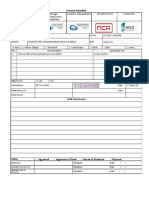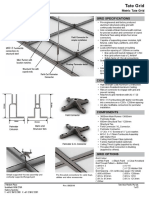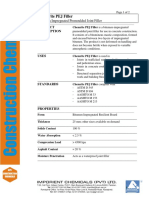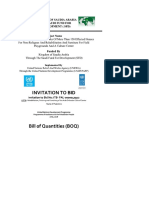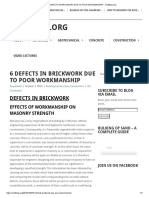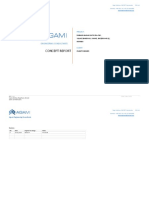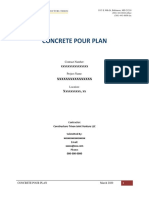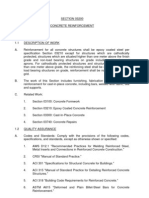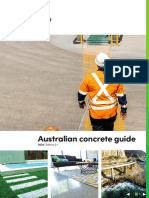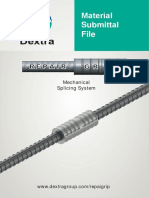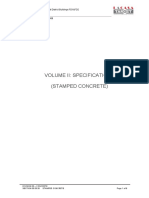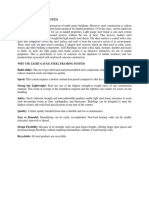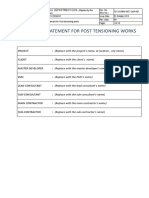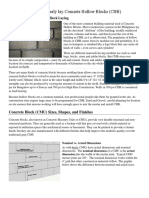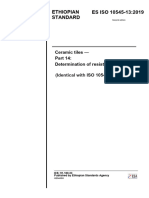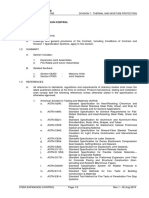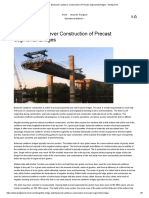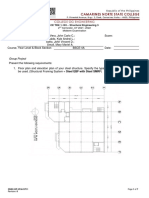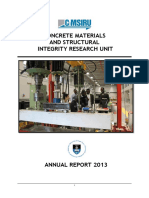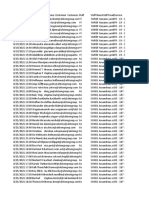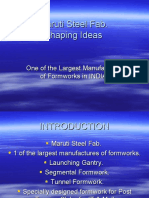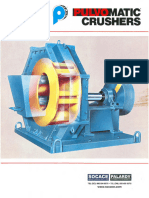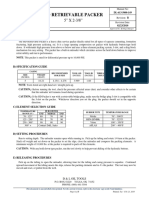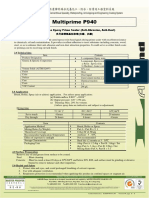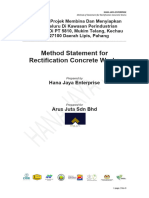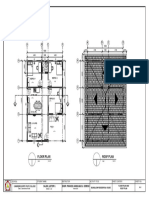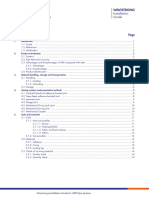Expansion Joint
Expansion Joint
Uploaded by
Abbas FarisCopyright:
Available Formats
Expansion Joint
Expansion Joint
Uploaded by
Abbas FarisOriginal Description:
Original Title
Copyright
Available Formats
Share this document
Did you find this document useful?
Is this content inappropriate?
Copyright:
Available Formats
Expansion Joint
Expansion Joint
Uploaded by
Abbas FarisCopyright:
Available Formats
PROPOSED ADDITIONAL G+2P+27 STOREY
RESIDENTIAL TOWER [TB]
ON PLOT NO. 6767876
AT DAMAC HILLS, DUBAI, UAE
Issue: 30 August 2021
SECTION 079500 - EXPANSION CONTROL
PART 1 - GENERAL
1.1 RELATED DOCUMENTS
1. Drawings and general provisions of the Contract, including
General and Supplementary Conditions and Division 01
Specification Sections, apply to this Section.
1.2 SUMMARY
1. This Section includes the following:
a. Architectural joint systems for building interiors.
b. Architectural joint systems for building exteriors.
2. The Contractor will execute all works in full compliance of the
following:
a. Dubai Green Building Regulations (DGBR) requirements.
b. Al Sa’fat Green Buildings Evaluation System.
2. Related Sections include the following:
a. Division 03 Section "Cast-in-Place Concrete" for cast-in
architectural-joint-system frames furnished, but not
installed, in this Section.
b. Division 04 Section "Unit Masonry" for masonry wall joint
systems.
c. Division 07 Section "Fire-Resistive Joint Systems" for liquid-
applied joint sealants in fire-resistive building joints.
d. Division 07 Section "Joint Sealants" for liquid-applied joint
sealants.
1.3 REFERENCES
1. All reference to standards, regulations and requirements of statutory
bodies shall mean the latest published editions at the time of
contract. Product manufacture, testing and installation shall comply
with the following references unless otherwise stated in the
specification or otherwise approved, but not limited to:
a. ASTM B 209 Standard Specification for
Aluminium and Aluminium Alloy
Sheet Plate.
b. ASTM B 221 Standard Specification for
Aluminium and Aluminium Alloy
Extruded Bars, Rods, Wire, Profiles
and Tubes.
c. ASTM D 1056 Standard Specification for Flexible
Cellular Materials – Sponge or
Expanded Rubber.
d. ASTM D 1751 Standard Specification for
Preformed Expansion Joint Filler for
Concrete Paving and Structural
Construction (Non-extruding and
Resilient Bituminous Types).
e. ASTM D 2000 Standard Classification System for
Rubber Products in Automotive
Applications.
f. ASTM E 1399 Standard Test Method for Cyclic
Movement and Measuring the
Minimum and Maximum Joint
Section 079500 – EXPANSION CONTROL Page 1 of 7
PROPOSED ADDITIONAL G+2P+27 STOREY
RESIDENTIAL TOWER [TB]
ON PLOT NO. 6767876
AT DAMAC HILLS, DUBAI, UAE
Issue: 30 August 2021
Widths of Architectural Joint
Systems.
g. ASTM E 1612 Standard Specification for
Preformed Architectural
Compression Seals for Buildings
and Parking Structures.
h. ASTM E 1783 Standard Specification for
Preformed Architectural Strip Seals
for Buildings and Parking Structures.
i. UL 2079 Standard for Fire resistance of
Building Joint Systems
1.4 PERFORMANCE REQUIREMENTS
1. General: Provide factory-fabricated architectural joint systems
capable of withstanding the types of loads and of accommodating the
kinds of movement, and the other functions for which they are
designed including those specified below, without failure. Types of
failure those listed in ASTM E 1399 Appendix X3.
a. Vehicular Traffic Joints: Support vehicular traffic across joint.
b. Pedestrian Traffic Joints: Support pedestrian traffic across
joint.
c. Exterior Joints: Maintain continuity of weather enclosure.
d. Joints in Fire-Resistance-Rated Assemblies: Maintain fire-
resistance ratings of assemblies.
e. Joints in Smoke Barriers: Maintain integrity of smoke barrier.
f. Other Joints: Where indicated, provide joint systems that
prevent penetration of water, moisture, and other substances
deleterious to building components or content.
g. Joints in surfaces with Architectural Finishes: Serve as
finished architectural joint closures.
h. Joint covers shall permit unrestrained movement of joint
without disengagement of cover
1.5 DEFINITIONS
1. Maximum Joint Width: Widest linear gap a joint system tolerates
and in which it performs its designed function without damaging its
functional capabilities.
2. Minimum Joint Width: Narrowest linear gap a joint system tolerates
and in which it performs its designed function without damaging its
functional capabilities.
3. Movement Capability: Value obtained from the difference between
widest and narrowest widths of a joint.
4. Nominal Joint Width: The width of the linear opening specified in
practice and in which the joint system is installed.
5. Fire Barriers: Any material or material combination, when fire
tested after cycling, designated to resist passage of flame and hot
gases through a movement joint.
1.6 SUBMITTALS
1. Shop Drawings: Provide the following for each joint system
specified and obtain approval prior to fabrication and shipment of
materials to the job site:
a. Placement Drawings: Refer plans, elevations, sections,
details for location of each joint system, and attachments to
other work. Where joint systems change planes, provide
isometric or clearly detailed drawing depicting how
components interconnect.
2. Product Data: Submit copies of manufacturer’s latest published
Section 079500 – EXPANSION CONTROL Page 2 of 7
PROPOSED ADDITIONAL G+2P+27 STOREY
RESIDENTIAL TOWER [TB]
ON PLOT NO. 6767876
AT DAMAC HILLS, DUBAI, UAE
Issue: 30 August 2021
literature for materials specified herein for approval, and obtain
approval before materials are fabricated and delivered to the site.
Data to clearly indicate movement capability of cover assemblies
and suitability of material used in exterior seal for UV exposure.
3. Each type of joint system indicated to Include manufacturer's color
charts showing the standard range of colors and finishes available
for each exposed metal and elastomeric seal material.
4. Certificates: Material test reports from qualified testing laboratory
indicating and interpreting test results relative to compliance of fire-
rated expansion joint assemblies with requirements indicated.
5. Load calculations for vehicular traffic expansion joint systems.
6. Samples: Full size units 150 mm long, of expansion joint indicated;
in sets for each finish, color, texture, and pattern specified, showing
full range of variations expected in these characteristics.
7. Comply with all the requirements of DGBR.
1.7 QUALITY ASSURANCE
1. Installer Qualifications: Approved by manufacturer.
2. Source Limitations: Obtain all architectural joint systems through
one source from a single manufacturer.
3. Product Options: Drawings indicate size, profiles, and dimensional
requirements of architectural joint systems and are based on the
specific systems indicated. Refer to Division 01 Section "Product
Requirements."
a. Do not modify intended aesthetic effects, as judged solely
by Engineer, except with Engineer's approval. If
modifications are proposed, submit comprehensive
explanatory data to Engineer for review.
4. Loading Characteristics: Standard loading refers to covers that are
capable of withstanding up to 500 lb. point loads. Heavy duty refers
to covers that are capable of withstanding up to 2000 lb. point
loads.
5. Fire-Test-Response Characteristics: Where indicated, provide
architectural joint system and fire-barrier assemblies identical to
those of assemblies tested for fire resistance per UL 2079 and/or
ASTM E 1966 by a testing and inspecting agency acceptable to
authorities having jurisdiction. Fire rating not less than the rating of
adjacent construction.
6. Manufacturer to provide 5-year warranty for all joint covers.
1.8 COORDINATION
1. Coordinate installation of exterior wall joint systems with roof
expansion assemblies to ensure that wall transitions are watertight.
PART 2 - PRODUCT
2.1 MATERIALS
1. Aluminum: ASTM B 221, Alloy 6005A-T61, 6063-T5, 6061-T5,
6105-T5 for extrusions; ASTM B 209, Alloy 6061-T6, 3003-H14,
5005-H34 for sheet and plate.
a. Apply manufacturer's standard protective coating on
aluminum surfaces to be placed in contact with cementitious
materials.
b. Mill Finish: AA-M10 (Mechanical Finish: as fabricated,
unspecified).
Section 079500 – EXPANSION CONTROL Page 3 of 7
PROPOSED ADDITIONAL G+2P+27 STOREY
RESIDENTIAL TOWER [TB]
ON PLOT NO. 6767876
AT DAMAC HILLS, DUBAI, UAE
Issue: 30 August 2021
c. Class II, Clear Anodic Finish: AA-M12C22A31 (Mechanical
Finish: nonspecular as fabricated; Chemical Finish: etched,
medium matte; Anodic Coating: Architectural Class II, clear
coating 0.010 mm or thicker) complying with AAMA 611.
d. Class II, Color Anodic Finish: AA-M12C22A32/A34
(Mechanical Finish: nonspecular as fabricated; Chemical
Finish: etched, medium matte; Anodic Coating: Architectural
Class II, integrally colored or electrolytically deposited color
coating 0.010 mm or thicker) complying with AAMA 611.
2. Elastomeric Seals: Preformed elastomeric membranes or extrusions
to be installed in metal frames.
3. Compression Seals: ASTM D2000; preformed rectangular
elastomeric extrusions having internal baffle system and designed
to function under compression.
4. Fire Barriers: Any material or material combination, when fire tested
after cycling, designated to resist the passage of flame and hot
gases through a movement joint and to meet performance criteria
for required rating period.
5. Moisture Barrier: 7-ply laminate reinforced Polyethylene.
6. Accessories: Manufacturer's standard anchors, clips, fasteners, set
screws, spacers, and other accessories compatible with material in
contact, as indicated or required for complete installations.
2.2 JOINT SYSTEMS, GENERAL
1. General: Provide architectural joint systems of design, basic profile,
materials, and operation indicated. Provide units with capability to
accommodate variations in adjacent surfaces.
2. Design architectural joint systems for the following size and
movement characteristics:
a. Nominal Joint Width: 100, 200 & 250 mm
b. Lateral Shear Movement Capability: to comply with Structural
Design & UAE Seismic requirements
2.3 ARCHITECTURAL JOINT SYSTEM TYPES
1. Manufacture to provide expansion joint cover assemblies specified
herein and indicated on the drawings. Other equivalent
manufacturers may be accepted as substitutions only if the
manufacturer can demonstrate product compliance with the
requirements of the contract documents. Substitution requests
must be reviewed prior to bid and must include the following
information:
a. Details
b. ASTM- E1399 test reports
c. Mock-ups
d. Reference list of projects with similar products as those
specified herein.
e. Sample of written 5-year warranty
2. Joint System for Parking Structures & BOH Areas.
a. Type/ Material: Metal plate. Exposed Metal: Aluminum. - Mill
finish.
b. Center plate design to allow for vertical movement without
cantilevering end of plate into the air.
c. Turnbar and center plate to have direct positive engagement
to protect center bolt from shearing forces. Systems that
transfer forces directly to the center bolts are not acceptable.
d. Attachment Method: Mechanical anchors
Section 079500 – EXPANSION CONTROL Page 4 of 7
PROPOSED ADDITIONAL G+2P+27 STOREY
RESIDENTIAL TOWER [TB]
ON PLOT NO. 6767876
AT DAMAC HILLS, DUBAI, UAE
Issue: 30 August 2021
e. Load Capacity: Heavy duty-pedestrian and vehicular traffic.
f. Fire-Resistance Rating: Provide joint system and fire-barrier
assembly with a rating not less than that of adjacent
construction.
g. Gutter: 7-ply laminate reinforced Polyethylene.
h. Wall and soffit cover plate: 2mm thick aluminum plate, mill
finish as per Section 05 5000 Metal Fabrication
3. Joint System for Landscape areas embedded under soil with
Aluminum. Flashing protection cover by MC.
a. Type/ Material: Aluminum. - Mill finish
b. Attachment Method: Mechanical anchors
c. Load Capacity: Heavy duty.
d. Fire-Resistance Rating: Provide joint system and fire-barrier
assembly with a rating not less than that of adjacent
construction.
e. Gutter: 7-ply laminate reinforced Polyethylene.
4. Joint System for External Landscape Paved finishes.
a. Type/ Material: Aluminum. - Mill finish
b. Attachment Method: Mechanical anchors
c. Load Capacity: Heavy duty –pedestrian traffic.
d. Fire-Resistance Rating: Provide joint system and fire-barrier
assembly with a rating not less than that of adjacent
construction.
e. Gutter: 7-ply laminate reinforced Polyethylene.
5. Joint System for Floor FOH.
a. Type / Material: Aluminum. - Mill finish
b. Attachment Method: Mechanical anchors
c. Load Capacity: Light duty.
d. Fire-Resistance Rating: Provide joint system and fire-
barrier assembly with a rating not less than that of adjacent
construction.
e. Gutter: 7-ply laminate reinforced Polyethylene for slab soffit,
not required for walls.
6. Joint System for Walls and Ceiling FOH.
a. Type / Material: Aluminum. - by others (ID)
b. Attachment Method: Mechanical anchors
c. Load Capacity: Light duty.
d. Fire-Resistance Rating: Provide joint system and fire-
barrier assembly with a rating not less than that of adjacent
construction.
2.4 FINISHES
1. Comply with NAAMM's "Metal Finishes Manual for Architectural and
Metal Products" for recommendations for applying and designating
finishes.
2. Protect mechanical finishes on exposed surfaces from damage by
applying a strippable, temporary protective covering before
shipping.
3. Appearance of Finished Work: Noticeable variations in same piece
are not acceptable.
PART 3 - EXECUTION
3.1 EXAMINATION
1. Examine surfaces and blockouts where architectural joint systems
Section 079500 – EXPANSION CONTROL Page 5 of 7
PROPOSED ADDITIONAL G+2P+27 STOREY
RESIDENTIAL TOWER [TB]
ON PLOT NO. 6767876
AT DAMAC HILLS, DUBAI, UAE
Issue: 30 August 2021
will be installed for installation tolerances and other conditions
affecting performance of work.
2. Proceed with installation only after unsatisfactory conditions have
been corrected.
3.2 PREPARATION
1. Prepare substrates according to architectural joint system
manufacturer's written instructions.
2. Repair concrete slabs and blockouts using manufacturer's
recommended repair grout of compressive strength adequate for
anticipated structural loadings.
3. Coordinate and furnish anchorages, setting drawings, and
instructions for installing joint systems. Provide fasteners of metal,
type, and size to suit type of construction indicated and to provide
for secure attachment of joint systems.
4. Cast-In Frames: Coordinate and furnish frames to be cast into
concrete.
3.3 INSTALLATION
1. Comply with manufacturer's written instructions for storing,
handling, and installing architectural joint assemblies and materials
unless more stringent requirements are indicated.
2. Metal Frames: Perform cutting, drilling, and fitting required to install
joint systems.
a. Install in true alignment and proper relationship to joints and
adjoining finished surfaces measured from established
lines and levels.
b. Adjust for differences between actual structural gap and
nominal design gap due to ambient temperature at time of
installation. Notify Engineer where discrepancies occur that
will affect proper joint installation and performance.
c. Cut and fit ends to accommodate thermal expansion and
contraction of metal without buckling of frames.
d. Locate in continuous contact with adjacent surfaces.
e. Heavy-Duty Systems: Repair or grout blockout as required
for continuous frame support and to bring frame to proper
level. Shimming is not allowed.
f. Locate anchors at interval recommended by
manufacturer, but not less than 75mm from each end and
not more than 600 mm c/c.
3. Seals in Metal Frames: Install elastomeric seals and membranes
in frames to comply with manufacturer's written instructions. Install
with minimum number of end joints.
a. Provide in continuous lengths for straight sections.
b. Seal transitions according to manufacturer's written
instructions. Vulcanize or heat- weld field-spliced joints as
recommended by manufacturer.
c. Installation: Mechanically lock seals into frames or adhere
to frames with adhesive or pressure-sensitive tape as
recommended by manufacturer.
4. Compression Seals: Apply adhesive or lubricant adhesive as
recommended by manufacturer before installing compression seals.
5. Terminate exposed ends of joint assemblies with field- or factory-
fabricated termination devices.
6. Fire-Resistance-Rated Assemblies: Coordinate installation of
architectural joint assembly materials and associated work so
Section 079500 – EXPANSION CONTROL Page 6 of 7
PROPOSED ADDITIONAL G+2P+27 STOREY
RESIDENTIAL TOWER [TB]
ON PLOT NO. 6767876
AT DAMAC HILLS, DUBAI, UAE
Issue: 30 August 2021
complete assemblies comply with assembly performance
requirements.
a. Fire Barriers: Install fire barriers to provide continuous,
uninterrupted fire resistance throughout length of joint,
including transitions and field splices.
7. Water Barrier: Provide water barrier at exterior joints and where
called for on Drawings. Provide drainage fittings where indicated.
3.4 PROTECTION
1. Do not remove protective covering until finish work in adjacent
areas is complete. When protective covering is removed, clean
exposed metal surfaces to comply with manufacturer's written
instructions.
2. Protect the installation from damage by work of other Sections.
Where necessary due to heavy construction traffic, remove and
properly store cover plates or seals and install temporary protection
over joints. Reinstall cover plates or seals prior to Substantial
Completion of the Work.
END OF SECTION
Section 079500 – EXPANSION CONTROL Page 7 of 7
You might also like
- Method Statement Aac BlocksDocument5 pagesMethod Statement Aac BlocksRizzat ZainalNo ratings yet
- MEP ClearanceDocument1 pageMEP ClearanceSa3id HassanNo ratings yet
- TBA - Hit and Miss FactsheetDocument2 pagesTBA - Hit and Miss FactsheetAdrianNo ratings yet
- Construction: Price List - Regional ManagersDocument23 pagesConstruction: Price List - Regional ManagersJoshua Hobson100% (1)
- HDB SOR - Jul 2013Document260 pagesHDB SOR - Jul 2013kokuei100% (1)
- S.g-Atc-Sub-0098 Bmu - With CC CommentsDocument64 pagesS.g-Atc-Sub-0098 Bmu - With CC CommentsHisham AL-OmariNo ratings yet
- AU Datacentre Structural Ceiling Grid 60CM DatasheetDocument9 pagesAU Datacentre Structural Ceiling Grid 60CM Datasheetguillote_666No ratings yet
- Deepseal 201 SpecificationDocument2 pagesDeepseal 201 Specificationjanithbogahawatta100% (1)
- Construction Specification Chain Link FenceDocument2 pagesConstruction Specification Chain Link Fenceyamanta_rajNo ratings yet
- Chemrite PEJ FillerDocument2 pagesChemrite PEJ FillerghazanfarNo ratings yet
- Specification PDFDocument54 pagesSpecification PDFsothilingamnNo ratings yet
- Boq PDFDocument63 pagesBoq PDFGULED FELEKENo ratings yet
- Safety Fences and Barriers For HighwaysDocument3 pagesSafety Fences and Barriers For HighwaysPriyeshBabarNo ratings yet
- (PDS) FlexcellDocument2 pages(PDS) Flexcellrazaze yannick100% (1)
- Template For Method StatementDocument12 pagesTemplate For Method StatementnaurahimanNo ratings yet
- BeamDocument6 pagesBeamFouad Hassan100% (1)
- Structural Cracks in BeamDocument2 pagesStructural Cracks in Beamswapnil gandhiNo ratings yet
- 6 Defects in Brickwork Due To Poor WorkmanshipDocument7 pages6 Defects in Brickwork Due To Poor WorkmanshipMichael Matshona100% (1)
- Installation Manual RMC050A - Rev.5Document42 pagesInstallation Manual RMC050A - Rev.5John LakNo ratings yet
- Cost Estimate - Single Storey BuildingDocument7 pagesCost Estimate - Single Storey BuildingSatya ArchangelNo ratings yet
- Checklist For Prequalification As A Building Construction ContractorDocument1 pageChecklist For Prequalification As A Building Construction ContractorUsman Shahid0% (1)
- TR 509 2Document185 pagesTR 509 2Ahmed GamgoumNo ratings yet
- 10.section 4.0 - Sewerage WorksDocument19 pages10.section 4.0 - Sewerage WorksNarain Muthukrishnan100% (1)
- NZS 3109 Concrete ConstructionDocument80 pagesNZS 3109 Concrete ConstructionShavneel ChandNo ratings yet
- Compliance StatementDocument2 pagesCompliance Statementshajeer1982No ratings yet
- ASTM C270-12a Masonry-MortarDocument14 pagesASTM C270-12a Masonry-Mortarsilvia paixãoNo ratings yet
- Aluminum Transmission Tower Bolts and Nuts: Standard Specification ForDocument4 pagesAluminum Transmission Tower Bolts and Nuts: Standard Specification ForkrutikNo ratings yet
- Commercial 95 340 - Product Profile - Rev. 13 Gale - May 2013Document1 pageCommercial 95 340 - Product Profile - Rev. 13 Gale - May 2013Aqil GhaffarNo ratings yet
- Nippon Steel Arcelor Mittal CatalogueDocument8 pagesNippon Steel Arcelor Mittal CatalogueReJeeS KhaNNo ratings yet
- NGO Monthly Progress ReportDocument94 pagesNGO Monthly Progress ReportRishiram MukhiyaNo ratings yet
- Sto Skim Coat 82216 Guide Specifications B26371Document4 pagesSto Skim Coat 82216 Guide Specifications B26371Anthony Al Lakiss100% (1)
- Qcs 2010 Part 27.03 Fences and GatesDocument4 pagesQcs 2010 Part 27.03 Fences and GatesRotsapNayrbNo ratings yet
- Concept Report For BuildingDocument13 pagesConcept Report For Buildingnimish.aquamarineNo ratings yet
- Concrete Pour PlanDocument19 pagesConcrete Pour PlanPablo Alejandro Jr100% (1)
- Concrete ReinforcementDocument5 pagesConcrete Reinforcementsethu1091No ratings yet
- Dormitory Bldg. 1 ECDocument10 pagesDormitory Bldg. 1 ECRianne GamboaNo ratings yet
- Reinforcement CouplersDocument24 pagesReinforcement Couplersvishalgore100% (2)
- Datasheet File - Conbextra GPDocument3 pagesDatasheet File - Conbextra GPmuraliNo ratings yet
- Borals Australian Guide To ConcreteDocument50 pagesBorals Australian Guide To ConcreteAlanNo ratings yet
- As 2701-2001 Methods of Sampling and Testing Mortar For Masonry ConstructionsDocument8 pagesAs 2701-2001 Methods of Sampling and Testing Mortar For Masonry ConstructionsSAI Global - APACNo ratings yet
- Material SumittalDocument73 pagesMaterial Sumittalsubash0% (1)
- The Use of Bonding Agents For Portland Cement PlasteringDocument3 pagesThe Use of Bonding Agents For Portland Cement PlasteringbatteekhNo ratings yet
- Reasonable Tolerances For Cast-In-Place Concrete - tcm45-345550Document5 pagesReasonable Tolerances For Cast-In-Place Concrete - tcm45-345550Magdy BakryNo ratings yet
- Revised BOQ Page 4.15-16 - (Car Park Layout)Document2 pagesRevised BOQ Page 4.15-16 - (Car Park Layout)shajbabyNo ratings yet
- Manholes and Inspection Chamber SizeDocument1 pageManholes and Inspection Chamber SizeKrishna PATELNo ratings yet
- 0503223-01-CIV-BOQ-1021-AB (Laundry Shed BOQ Comparision)Document6 pages0503223-01-CIV-BOQ-1021-AB (Laundry Shed BOQ Comparision)CCCCCCC100% (1)
- Renderoc LAXtraDocument2 pagesRenderoc LAXtraMansoor Ali100% (1)
- Barbed Wire Fencing Over Boundary WallDocument1 pageBarbed Wire Fencing Over Boundary WallAh Rashed100% (1)
- BRICKS As Per ASTM StandardsDocument19 pagesBRICKS As Per ASTM StandardsRocel Mae PalianaNo ratings yet
- MS For Kerb Stone FixingDocument67 pagesMS For Kerb Stone FixingAdrian FrantescuNo ratings yet
- Volume Ii: Specifications (Stamped Concrete) : Issue: FINAL, 14th FEB 2013Document8 pagesVolume Ii: Specifications (Stamped Concrete) : Issue: FINAL, 14th FEB 2013Ahmad Saadeldin100% (1)
- LGS Erection Methodology by Nabeel AmjadDocument14 pagesLGS Erection Methodology by Nabeel AmjadNabeel SheikhNo ratings yet
- TEC 033800 MET DoR 001 (Method Statement For Post Tension Works) (K)Document10 pagesTEC 033800 MET DoR 001 (Method Statement For Post Tension Works) (K)Muhammad Haziq100% (2)
- MasonDocument7 pagesMasonMichael Jherome NuqueNo ratings yet
- Deflection Egyptian CodeDocument3 pagesDeflection Egyptian CodeMagdy BakryNo ratings yet
- Es Iso - 10545-14 - 2019Document12 pagesEs Iso - 10545-14 - 2019Addisu PetrosNo ratings yet
- Ardex Waterproofing GuideDocument36 pagesArdex Waterproofing GuideHarsa VardhanNo ratings yet
- 8.19.3 Laying: 8.20 Curtain W T T ALL W W With Aluminium Composite Panels (Acp) Cladding P P 8.20.1 GeneralDocument5 pages8.19.3 Laying: 8.20 Curtain W T T ALL W W With Aluminium Composite Panels (Acp) Cladding P P 8.20.1 GeneralAnshuman RathNo ratings yet
- Section 07950 Expansion ControlDocument5 pagesSection 07950 Expansion ControlMØhãmmed ØwięsNo ratings yet
- ACP SpecsDocument8 pagesACP SpecsJana jerodyNo ratings yet
- Balanced Cantilever Construction of Precast Segmental Bridges - BridgeTechDocument8 pagesBalanced Cantilever Construction of Precast Segmental Bridges - BridgeTechSilvio CarrilloNo ratings yet
- IFSC MICR Code DetailsDocument27 pagesIFSC MICR Code DetailssrisudhindraNo ratings yet
- MOS-QC-E004-rev.1 Lighting Fixtures InstallationsDocument8 pagesMOS-QC-E004-rev.1 Lighting Fixtures InstallationsAhmed IbrahimNo ratings yet
- E Cel Cables: General Wiring Price ListDocument1 pageE Cel Cables: General Wiring Price ListTauseef Taj KianiNo ratings yet
- 07.01 Risk Assessment For Fire Alarm SystemDocument15 pages07.01 Risk Assessment For Fire Alarm SystemShah MuzzamilNo ratings yet
- SE3M ExamDocument7 pagesSE3M ExamMariel UNo ratings yet
- 6-44-0013 2013 Standard Specification For Inspection, Flushing and Testing of Piping SystemsDocument9 pages6-44-0013 2013 Standard Specification For Inspection, Flushing and Testing of Piping SystemsdgkmurtiNo ratings yet
- 3.2 Method - Statement - For - Construction - of - Civil - WorksDocument23 pages3.2 Method - Statement - For - Construction - of - Civil - WorksJoseph EgonaNo ratings yet
- Complex Lift Plan and ChecklistDocument3 pagesComplex Lift Plan and Checklistsudeesh kumar100% (1)
- Concrete Materials and Structural Integrity Research UnitDocument32 pagesConcrete Materials and Structural Integrity Research UnitLeoNo ratings yet
- FR 003 Work-at-Height-ChecklistDocument1 pageFR 003 Work-at-Height-Checklistum erNo ratings yet
- Design and Construction of Offshore Concrete Structures: February 2017Document18 pagesDesign and Construction of Offshore Concrete Structures: February 2017Suraj PandeyNo ratings yet
- TGCC001.HSE - PR01 Fall Protection ProcedureDocument14 pagesTGCC001.HSE - PR01 Fall Protection ProcedureAjmal MohamedNo ratings yet
- Bookings Reporting DataDocument45 pagesBookings Reporting DataKoushik KrithivasanNo ratings yet
- Paper On Design Voded SlabDocument9 pagesPaper On Design Voded SlabAnonymous b9fkTYfEoRNo ratings yet
- Maruti Steel Fab. Shaping IdeasDocument25 pagesMaruti Steel Fab. Shaping Ideasrobin_th01No ratings yet
- Field Density Test (FDT) Using Sand Cone Method: Soil Mechanics Laboratory Balmores, Janmar Luisce IDocument11 pagesField Density Test (FDT) Using Sand Cone Method: Soil Mechanics Laboratory Balmores, Janmar Luisce IJanmar BalmoresNo ratings yet
- PulvoMatic AzulDocument5 pagesPulvoMatic AzulGABRIEL RONDO CUBA (PSICOLOGO-INVESTIGADOR)100% (1)
- Australian Standard: Cranes, Hoists and Winches Part 8: Special Purpose AppliancesDocument57 pagesAustralian Standard: Cranes, Hoists and Winches Part 8: Special Purpose AppliancesAnandan Thangasamy100% (1)
- Purlin Design ReportDocument45 pagesPurlin Design ReportTrungNguyenNo ratings yet
- Baseline ADU Proposal For Community Discussion - Updated 3.15.23Document3 pagesBaseline ADU Proposal For Community Discussion - Updated 3.15.23WVXU NewsNo ratings yet
- HD Packer 3-4-5Document5 pagesHD Packer 3-4-5Alain AlemanNo ratings yet
- Multiprime P940: Multi Purpose Epoxy Prime Sealer (Anti-Abrasion, Anti-Dust)Document1 pageMultiprime P940: Multi Purpose Epoxy Prime Sealer (Anti-Abrasion, Anti-Dust)Helen ChoiNo ratings yet
- MOS RectificationDocument6 pagesMOS Rectificationfaridhalim.steNo ratings yet
- SALEN-1 (Floor Plan & Roof Plan)Document1 pageSALEN-1 (Floor Plan & Roof Plan)John SecretNo ratings yet
- Jumeirah 6-49 - Ac26 - 03Document17 pagesJumeirah 6-49 - Ac26 - 03Lê Quý ĐạiNo ratings yet
- A E1106 Pages: 2: Answer Any Two Full Questions, Each Carries 15 MarksDocument2 pagesA E1106 Pages: 2: Answer Any Two Full Questions, Each Carries 15 MarksGenNo ratings yet
- CH 4 FoundationDocument43 pagesCH 4 FoundationEyoatem Teferi100% (1)
- Wavistrong Installation Guide - Part5Document1 pageWavistrong Installation Guide - Part5gfhf dgdNo ratings yet
